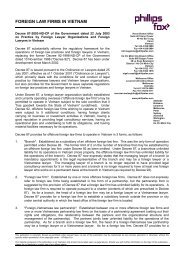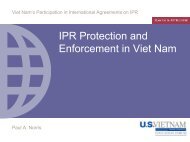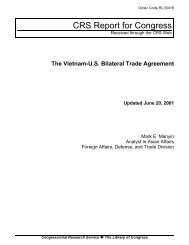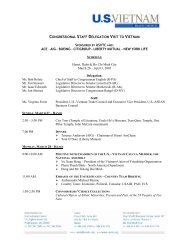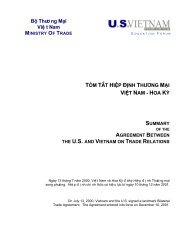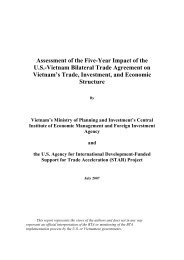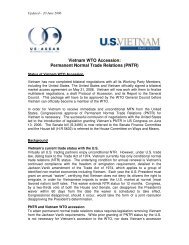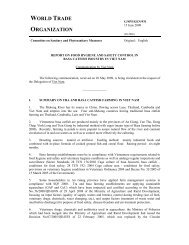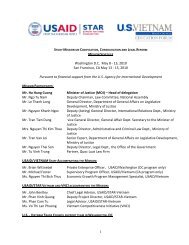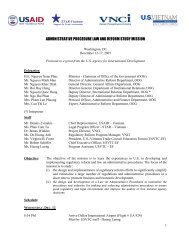Climate risks and adaptation in Asian coastal megacities: A synthesis
Climate risks and adaptation in Asian coastal megacities: A synthesis
Climate risks and adaptation in Asian coastal megacities: A synthesis
- No tags were found...
You also want an ePaper? Increase the reach of your titles
YUMPU automatically turns print PDFs into web optimized ePapers that Google loves.
Box 3.4 ■ Overview of Downscal<strong>in</strong>g <strong>and</strong> Hydrological Analysis Carried out forHCMC StudyGHG Emission Scenarios PRECIS IR3SHigh +7.5 (A2) +4.4 (A1FI)Low +1.5 (B2) +2.9 (B1)Low-resolution outputs (~2o) from ECHAM’s (European Centre for Medium Range Weather Forecast-University of Hamburg) atmosphere-ocean-coupledglobal circulation model (GCM) Version 4 were downscaled by PRECIS (Provid<strong>in</strong>g Regional <strong>Climate</strong>s for Impacts Studies, <strong>and</strong> a dynamic model<strong>in</strong>g tooldeveloped by the UK Met Office Hadley Centre for <strong>Climate</strong> Prediction <strong>and</strong> Research, precis.metoffice.com). Two IPCC SRES greenhouse gas emissionscenarios were used as <strong>in</strong>puts to the GCM. SRES A2 is a high-emission scenario, while B2 represents the low-emission world.ECHAM is considered a “moderate” GCM <strong>in</strong> that it does not give any extreme temperature or precipitation projections, but tends to be <strong>in</strong> themiddle ranges. However, other GCM’s are also available <strong>and</strong> need to be <strong>in</strong>cluded <strong>in</strong> subsequent studies. PRECIS was used because it is the regionalmodel<strong>in</strong>g tool that has been most widely used globally, as well as be<strong>in</strong>g the tool that the UNDP National Communication Support Unit recommendsfor countries receiv<strong>in</strong>g GEF fund<strong>in</strong>g.PRECIS gridded outputs at resolution 0.22o (~25km) for the Sai Gon-Dong Nai Bas<strong>in</strong> were provided by SEA START RC. Daily outputs for maximum/m<strong>in</strong>imum temperature <strong>and</strong> ra<strong>in</strong>fall for the basel<strong>in</strong>e decade (1994–2003) <strong>and</strong> a future decade (2050–59), which represent the year 2050, were takenas a key <strong>in</strong>put for the hydrodynamic model—HydroGIS—to calculate the water <strong>and</strong> flood regime of Ho Chi M<strong>in</strong>h City. PRECIS gave the total <strong>and</strong>seasonal ra<strong>in</strong>fall anomalies that are comparable, though with a slightly wider range than the JBIC/IR3S ensemble, which was used by the other citystudies <strong>in</strong> this collaborative <strong>in</strong>itiative (see table below). By us<strong>in</strong>g PRECIS, the daily outputs as well as spatial distribution of climate variables were alsoobta<strong>in</strong>ed to get more <strong>in</strong>-depth <strong>in</strong>formation on temporal <strong>and</strong> geographic variables for the study area.The table below provides a comparison of 10 years averaged June-July-August ra<strong>in</strong>fall from PRECIS <strong>and</strong> the IR3S ra<strong>in</strong>fall ensemble for Ho ChiM<strong>in</strong>h City for the year 2050 (%change relative to basel<strong>in</strong>e)Monsoon-driven seasonal ra<strong>in</strong>fall years with maximum <strong>and</strong> m<strong>in</strong>imumannual ra<strong>in</strong>fall for each decade were selected to represent “wet” <strong>and</strong>“dry” years of the basel<strong>in</strong>e <strong>and</strong> future A2 <strong>and</strong> B2 decades.Event-based ra<strong>in</strong>fall extremes for the basel<strong>in</strong>e <strong>and</strong> future timeslices were derived from the 1-, 3-, 5-, <strong>and</strong> 7-day maximum ra<strong>in</strong>fall fromPRECIS over the HCMC urban area. Extreme ra<strong>in</strong>falls of 30- <strong>and</strong> 100-yearreturn periods were extrapolated from the log-log (power) regressionbetween the frequency of occurrence (years) <strong>and</strong> amount of each ra<strong>in</strong>fall extreme. The 30-year <strong>and</strong> 100-year extremes <strong>and</strong> 1-, 3-, 5-, <strong>and</strong> 7-day ra<strong>in</strong>falldata were rescaled to the observed extreme ra<strong>in</strong>falls at Tan Song Nhat Airport. The scal<strong>in</strong>g factors for each extreme period were used for scal<strong>in</strong>g therespective future extreme ra<strong>in</strong>fall.Source: Adapted from ADB (2010).master plan prepared by the Department of Plann<strong>in</strong>g<strong>and</strong> Architecture, the l<strong>and</strong> use plan preparedby DoNRE, <strong>and</strong> the socioeconomic developmentplan prepared by the Department of Plann<strong>in</strong>g<strong>and</strong> Investment. These are prepared by differentagencies under different time scales with littlecoord<strong>in</strong>ation between them, thus pos<strong>in</strong>g a difficultproblem <strong>in</strong> estimat<strong>in</strong>g future <strong>in</strong>frastructure <strong>and</strong>urbanization scenarios. In terms of a developmentscenario for 2050, HCMC has an urban master planthat was approved <strong>in</strong> 1998. In 2007, a study wascompleted to adjust the HCMC master plan upto 2025 (commonly referred to as the AdjustmentPlan). 40 The city case study used the Adjustment Planas the basis of the most likely development scenario for2050 (ADB 2010).In terms of l<strong>and</strong> use, key trends <strong>in</strong>clude a decl<strong>in</strong><strong>in</strong>gpopulation <strong>in</strong> central HCMC; doughnut-shapedurbanization, with higher population growth with<strong>in</strong>10 kms from the center of the city; <strong>and</strong> <strong>in</strong>dustries be<strong>in</strong>grelocated <strong>and</strong> established <strong>in</strong> <strong>in</strong>dustrial zones. Agriculture<strong>and</strong> forest l<strong>and</strong> (primarily made up by theCan Gio biosphere reserve) situated <strong>in</strong> the rural <strong>and</strong>suburban areas, has decl<strong>in</strong>ed from 64 percent <strong>in</strong> 1997to 59 percent <strong>in</strong> 2006. Accord<strong>in</strong>g to DONRE’s l<strong>and</strong>use plans, open space is expected to decl<strong>in</strong>e by 25percent by 2020 (ADB 2010). Rivers <strong>and</strong> canals coverclose to 15 percent of the total l<strong>and</strong> use, reflect<strong>in</strong>g the40Even though it is <strong>in</strong> the process of be<strong>in</strong>g formally approvedby the government, <strong>in</strong> the <strong>in</strong>terim, it is the recognizedupdate for the 1998 Master Plan.42 | <strong>Climate</strong> Risks <strong>and</strong> Adaptation <strong>in</strong> <strong>Asian</strong> Coastal Megacities: A Synthesis Report



